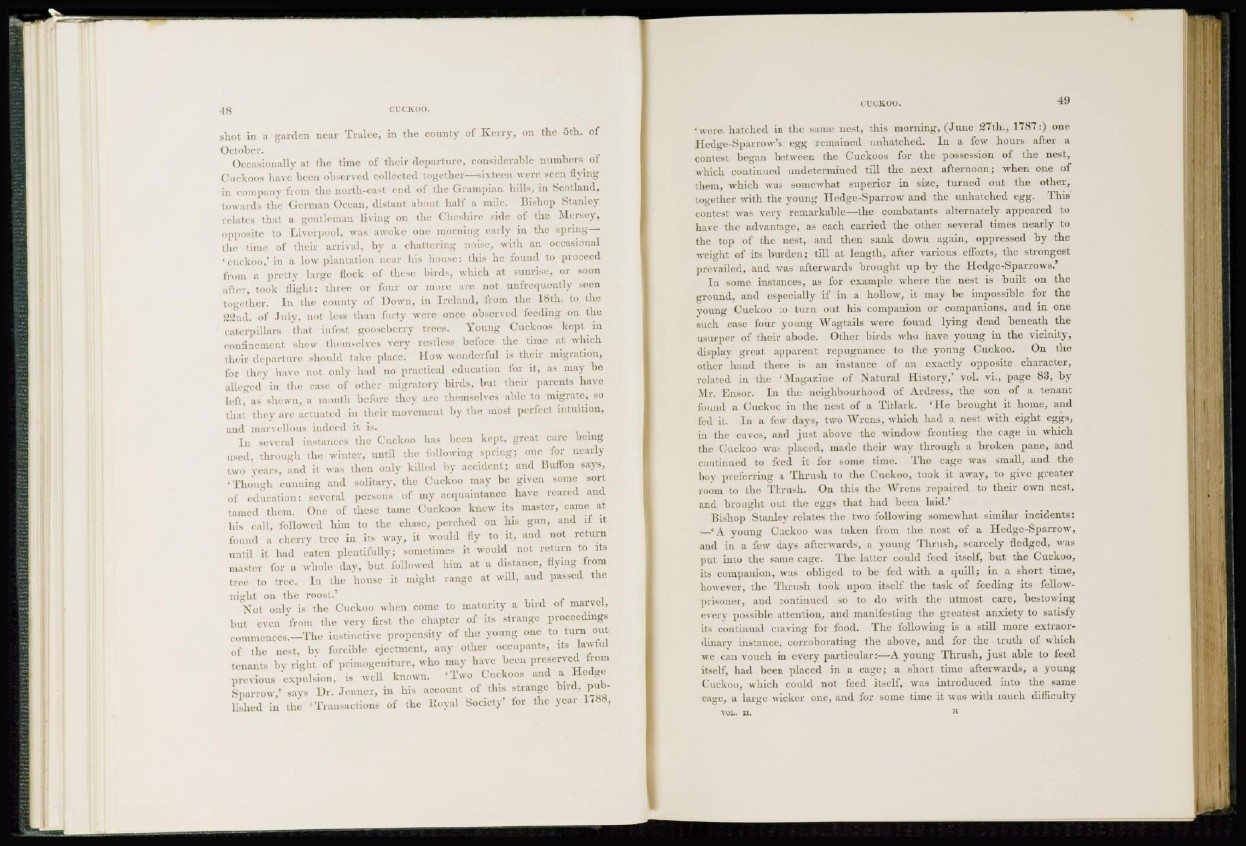
shot in a garden near Tralce, in the county of Kerry, on the 5th. of
October.
Occasionally at the time of their departure, considerable numbers of
Cuckoos have been observed collected together—sixteen were seen thing
in company from the north-east end of the Grampian hills, in Scotland,
towards the German Ocean, distant about half a mile. Bishop Stanley
relates that a gentleman living on the Cheshire side of the Mersey,
opposite to Liverpool, was awoke one morning early in the spring—
the time of their arrival, by a chattering noise, with an occasional
'cuckoo/in a low plantation near his house: this he found to proceed
from a pretty large Hock of these birds, which at sunrise, or soon
after, took flight: three or four or more are not unfrequcutly seen
together. In the county of Down, in Ireland, from the 18th. to the
22nd. of .Inly, not less than forty were once observed feeding on the
caterpillars that infest gooseberry trees. Young Cuckoos kept in
confinement shew themselves very restless before the time at which
their departure should take place. How wonderful is their migration,
for thev have not onlv had no practical education for it, as may be
alleged in the case of other migratory birds, but their parents have
left, as shewn, a mouth before they are themselves able to migrate, so
that they are actuated in their movement by the most perfect intuition,
and marvellous indeed it is.
In several instances the Cuckoo has been kept, great care being
used, through the winter, until the following spring; one for nearly
two years, and it was then only killed by accident; and Buffon says,
'Though cunning and solitary, the Cuckoo may be given some sort
of education: several persons of my acquaintance have reared and
tamed them. One of these tame Cuckoos knew its master, came at
his call, followed him to the chase, perched on his gun, and if it
found a cherry tree iu its way, it would fly to it, and not return
until it had eaten plentifully; sometimes it would not return to its
master for a whole day, but followed him at a distance, flying from
tree to tree. In the house it might range at will, and passed the
night on the r o o s t .'
Not only is the Cuckoo when come to maturity a bird of marvel,
but even from the very first the chapter of its strange proceedings
commences.—The instinctive propensity of the young one to turn out
of the nest, by forcible ejectment, any other occupants, its lawful
tenants by right of primogeniture, who may have been preserved from
previous expulsion, is well known. 'Two Cuckoos and a Hedge
Sparrow,1 says Dr. Jenner, in his account of this strange bird, published
in the 'Transactions of the lioyal Society' for the year 1788,
'were hatched in the same nest, this morning, (June 27th., 1787:) one
Hedge-Sparrow's egg remained unhatched. In a few hours after a
contest began between the Cuckoos for the possession of the nest,
which continued undetermined till the next afternoon; when one of
them, which was somewhat superior in size, turned out the other,
together with the young Hedge-Sparrow and the unhatched egg. This
contest was very remarkable—the combatants alternately appeared to
have the advantage, as each carried the other several times nearly to
the top of the nest, and then sank down again, oppressed by the
weight of its burden; till at length, after various efforts, the strongest
prevailed, and was afterwards brought up by the Hedgc-Sparrows.'
In some instances, as for example where the nest is built on the
ground, and especially if in a hollow, it may be impossible for the
young Cuckoo to turn out his companion or companions, and in one
such case four* young Wagtails were found lying dead beneath the
usurper of their abode. Other birds who have young in the vicinity,
display great apparent repugnance to the young Cuckoo. On the
other hand there is an instance of an exactly opposite character,
related in the 'Magazine of Natural History/ vol. vi., page 83, by
Mr. Ensor. In the neighbourhood of Ardress, the son of a tenant
found a Cuckoo in the nest of a Titlark. 'He brought it home, and
fed it. In a few days, two Wrens, which had a nest with eight eggs,
in the caves, and just above the window fronting the cage in which
the Cuckoo was placed, made their way through a broken pane, and
continued to feed it for some time. The cage was small, and the
boy preferring a Thrush to the Cuckoo, took it away, to give greater
room to the Thrush. On this the Wrens repaired to their own nest,
and brought out the eggs that had been laid.'
Bishop Stanley relates the two following somewhat similar incidents:
—'A young Cuckoo was taken from the nest of a Hedge-Sparrow,
and in a few days afterwards, a young Thrush, scarcely fledged, was
put into the same cage. The latter could feed itself, but the Cuckoo,
its companion, was obliged to be fed with a quill; in a short time,
however, the Thrush took upon itself the task of feeding its fellowprisoner,
and continued so to do with the utmost care, bestowing
every possible attention, and manifesting the greatest anxiety to satisfy
its continual craving for food. The following is a still more extraordinary
instance, corroborating the above, and for the truth of which
we can vouch in every particular:—A young Thrush, just able to feed
itself, had been placed in a cage; a short time afterwards, a young
Cuckoo, which could not feed itself, was introduced into the same
eage, a large wicker one, and for some time it was with much difficulty